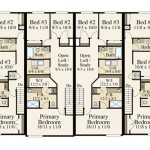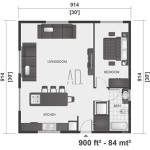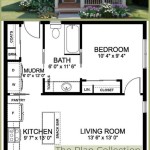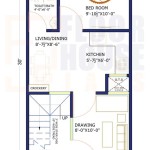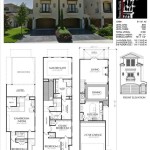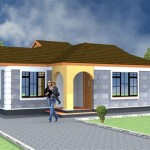The Enduring Appeal and Practical Considerations of Open Floor Plans
Open floor plans have become a dominant trend in contemporary home design, transforming the way people experience and interact with their living spaces. This design approach, characterized by the merging of traditionally separate rooms such as the living room, dining room, and kitchen into a single, expansive area, offers a unique blend of aesthetic appeal and practical functionality. Understanding the benefits, drawbacks, and design considerations associated with open floor plans is crucial for homeowners seeking to create a living environment that aligns with their lifestyle and preferences.
The popularity of open floor plans has evolved significantly over the past several decades. Prior to the mid-20th century, homes were typically designed with closed-off rooms, each serving a distinct purpose and separated by walls and doors. However, as lifestyles became more casual and families sought more interactive living spaces, the demand for open floor plans began to rise. The desire for a more communal atmosphere, coupled with advancements in construction technology that allowed for larger, uninterrupted spaces, fueled the proliferation of this design trend.
Today, open floor plans are found in a wide range of housing types, from sprawling suburban homes to compact urban apartments. Their versatility and ability to adapt to various architectural styles have solidified their position as a staple of modern home design. Understanding the nuances of this design concept is essential for homeowners considering a renovation or new construction project.
Enhancing Social Interaction and Family Connectivity
One of the most compelling advantages of open floor plans is their ability to foster social interaction and enhance family connectivity. By eliminating physical barriers between living spaces, open floor plans create a more inclusive and engaging environment. Family members can interact seamlessly while engaged in different activities, such as cooking, watching television, or doing homework. This promotes a sense of togetherness and facilitates communication, allowing for more spontaneous and meaningful interactions.
In traditional closed-off layouts, individuals may feel isolated while performing tasks in separate rooms. For example, a parent preparing dinner in the kitchen might be disconnected from children playing in the living room. Open floor plans address this issue by creating a visual and auditory connection between these spaces. Parents can easily supervise children while cooking, or engage in conversation with family members relaxing in the living area. This enhanced connectivity can strengthen family bonds and create a more harmonious living environment.
The benefits of improved social interaction extend beyond the immediate family. Open floor plans are ideal for entertaining guests, as they allow for a more seamless flow of conversation and movement. Hosts can easily interact with guests while preparing food or drinks, creating a more relaxed and welcoming atmosphere. The open space encourages mingling and interaction, making it easier for guests to connect with one another. This makes open floor plans particularly well-suited for social gatherings and celebrations.
Furthermore, open floor plans can be particularly beneficial for families with young children. The ability to easily monitor children from different areas of the home provides parents with peace of mind and allows them to respond quickly to any needs or concerns. This enhanced visibility can contribute to a safer and more secure environment for young children, allowing them to explore and play while remaining within their parents' watchful eye.
Maximizing Space and Natural Light
Another significant advantage of open floor plans is their ability to maximize space and natural light. By removing interior walls, open floor plans create a sense of spaciousness and airiness, making even smaller homes feel larger and more inviting. This is particularly beneficial in urban environments where space is often limited. The elimination of walls also allows for a more efficient use of available square footage, as there are no wasted spaces or narrow hallways.
Open floor plans also enhance the flow of natural light throughout the home. With fewer obstructions, sunlight can penetrate deeper into the interior, illuminating the entire living space. This can reduce the need for artificial lighting, saving energy and creating a more cheerful and vibrant atmosphere. Natural light has been shown to have numerous health benefits, including improved mood, increased productivity, and better sleep quality. By maximizing natural light, open floor plans can contribute to a healthier and more comfortable living environment.
The feeling of spaciousness created by open floor plans can also have a positive impact on mental well-being. Cluttered and confined spaces can contribute to feelings of stress and anxiety, while open and airy environments can promote a sense of calm and relaxation. The ability to move freely throughout the living space without feeling confined can enhance a sense of freedom and well-being. This makes open floor plans particularly appealing to individuals who value a sense of openness and connection to their surroundings.
Furthermore, the open design allows for greater flexibility in furniture placement and arrangement. Without the constraints of walls and doorways, homeowners can create a variety of different living zones within the open space, tailoring the layout to their specific needs and preferences. This adaptability makes open floor plans well-suited for individuals with evolving lifestyles or those who enjoy rearranging their living spaces periodically.
Addressing Potential Drawbacks and Design Considerations
Despite the numerous advantages, open floor plans also present potential drawbacks that must be carefully considered. One of the most common concerns is noise control. With no walls to buffer sound, noise can travel freely throughout the open space, potentially disrupting activities or causing distractions. This can be particularly problematic in households with multiple occupants engaged in different activities simultaneously. Effective noise management strategies are essential for mitigating this issue.
Another potential drawback is a lack of privacy. In open floor plans, there are fewer opportunities for individuals to retreat to a private space for relaxation or focused work. This can be challenging for individuals who value their privacy or who require a quiet environment for concentration. Incorporating designated quiet zones or using screens or partitions can help to address this issue.
Temperature management can also be a challenge in open floor plans. Without walls to compartmentalize the space, it can be more difficult to regulate the temperature in different areas of the home. This can lead to uneven heating or cooling, potentially impacting comfort and energy efficiency. Using strategically placed ceiling fans, zoned heating and cooling systems, or insulated window treatments can help to mitigate this issue.
Furthermore, maintaining a sense of visual order and cohesiveness in an open floor plan requires careful planning and design considerations. Without walls to define boundaries, it can be challenging to create distinct living zones and maintain a consistent aesthetic throughout the space. Using furniture arrangements, area rugs, and varying paint colors can help to delineate different areas and create a sense of visual separation. Consistent design elements, such as flooring, lighting, and decorative accents, can help to tie the space together and create a cohesive look.
Finally, it is important to consider the structural implications of removing walls to create an open floor plan. Load-bearing walls play a crucial role in supporting the structure of the home, and removing them without proper planning and reinforcement can compromise the integrity of the building. Consulting with a qualified structural engineer or architect is essential to ensure that any wall removal is done safely and in accordance with building codes.
In summary, open floor plans offer a compelling blend of aesthetic appeal and practical functionality, but it is crucial to carefully weigh the benefits and drawbacks before embracing this design approach. Understanding the potential challenges and implementing appropriate design solutions can help homeowners create a living environment that is both beautiful and functional.
Careful consideration of these design elements, alongside an understanding of the advantages and potential drawbacks associated with open floor plans, allows homeowners to create a space that is both aesthetically pleasing and perfectly suited to their individual needs and lifestyles.

Pros And Cons Of An Open Concept Floor Plan Generation Homes Nw

Modern Open Floor House Plans Blog Eplans Com
:max_bytes(150000):strip_icc()/1660-Union-Church-Rd-Watkinsville-Ga-Real-Estate-Photography-Mouve-Media-Web-9-77b64e3a6fde4361833f0234ba491e29.jpg?strip=all)
18 Open Floor House Plans Built For Entertaining

House Design Trends What S Popular In Cur Floor Plans Extra Space Storage

Free Editable Open Floor Plans Edrawmax

Open Floor Plans Build A Home With Smart Layout Blog Dreamhomesource Com

30 Gorgeous Open Floor Plan Ideas How To Design Concept Spaces

What S The Deal With Open Floor Plans Whitmore Homes

Open Floor Plans Creating A Breathable Livable Custom Home Builders Schumacher Homes

Classic House Plans Open Floor Concept


